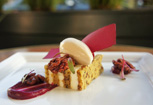

Pastry chefs draw inspiration
from the veggie patch
By Laurel May
Did Alain Passard pave the way for veggie-based dessert acceptance with his Tomate Confit Farcie Aux Douze? Or was it the more recent creations of Sam Mason for WD-50? Maybe the dining public is just finally ready to throw in the napkin on Lava Cake. Whatever the origin, increasing numbers of boundary-pushing chefs are taking inspiration from the vegetable patch and twisting the dessert dial from sweet to savory – and diners are responding.
From tradition to seasonal inspiration
An eggplant and chocolate dessert on an American restaurant menu may be somewhat shocking, but back in the Italian homeland, the combination is nothing new. Often, vegetable-based desserts are not the flights of fancy of daydreaming chefs – they’re rock-solid, traditional combinations. In Newport Beach, at Tamarind of London, Executive Chef Shachi Mehra serves a Carrot Halwa – a dish which many Western diners find surprising, but which is something of a comfort food staple in Indian culture. Similarly, at San Francisco’s La Mar, Chef de Cuisine Dennis Arvizu delights traditionalists and risk-takers alike with a final course featuring vegetables. Chef Dennis’s Pumpkin and Sweet Potato Picarones, which are more widely known as fritters, are “the Peruvian must-have dessert. We would have very disappointed guests if they were to be off the menu,” he insists.
Other chefs take their cues from fresh, seasonal produce and simply pick a flavor or an ingredient and run with it. Pastry Chef Bill Corbett of San Francisco’s Absinthe, “. . . wanted to do something with beets, along the lines of a carrot cake.” To prepare his Beet Cake, Corbett roasts beets, “Just as a savory chef would,” squeezes excess juice from the tubers, combines them with the classic pairing of goat cheese and walnuts then adds just a touch of sugar to, “sweeten it just a bit more, to make it feel like a dessert.”
Stumbling upon some albino beets at a local farmer’s market, Trevor Ogden of San Francisco’s Chambers Eat + Drink was also inspired to come up with a fresh way to present the beet/walnut/goat cheese trio. “I almost got sick of the idea of having these three ingredients together.” His wife’s love of a classic dessert led him to add a small amount of goat cheese and puree milk with beets and add them to a traditional cheesecake recipe. “I tried it a few times, tweaking the recipe . . .” Ogden’s trial and error eventually led to the Beet and Goat Cheesecake which now appears on the Chambers menu.
For Kitchen Door Chef/Founder Todd Humphries, his Candy Cap Mushroom Pudding was born of a fungi tasting menu based on local and seasonal practices. “To be honest, I have mostly focused on different varieties of mushrooms because of the challenge to create something that [would make people say] ‘Wow! A mushroom dessert!’”
Pastry Chef Ana Paliza-Brown of the San Francisco’s Txoko, took the ingredient cues for her Date Bread Pudding with Olive Caramel from Spanish regional fare that is offered at the restaurant, over solely Bay Area influences. “In trying to use Basque, Spanish and French ingredients for our Basque-inspired concept, olives were an obvious choice.” Combine traditional techniques with California bounty, and the result is often a contemporary and unique twist on traditional dishes. “I think it’s just a desire to incorporate something you love into a dish. Whether you are a sweet or a savory cook, there are certain ingredients that you are passionate about and want to challenge yourself creatively in incorporating them into your food.”
Selling savory
Today’s more adventurous diner may be likely to order a vegetable-based dessert, but chefs acknowledge there are a few secrets to easing more cautious customers into the trend. A menu balance of more innovative desserts with traditional favorites is one way to urge first-timers to take a bite, and building trust is also key. Paliza-Brown advises chefs to “ . . .introduce the vegetable as part of a garnish instead of the main component of the dish. This way, guests that might not be very adventurous will still consider trying it.”
Ogden feels there’s a growing market for savory dessert experiences. “There is definitely a following of foodies who search for this kind of dessert and then there are the people who stumble upon it and are greatly surprised.” And what about those stick-in-the-mud crème brulée and chocolate cake types? “The only challenge is getting the customer to forget that [the dessert includes] a vegetable and is only supposed to be used in savory dishes. Once they get past that, and actually try the dish, their minds will be changed – or they won’t.”
Another approach to inching customers toward acceptance, is sharing the background of the dish with diners. “Connect to the guest on some level – whether it be seasonal, or have some back story,” says Mehra. Properly framing new dishes in terms of description and presentation aids with consumer understanding of a dish, which in turn, often equals increased sales says Humphries, “Due to the culture of seasonality and local produce,” with a tantalizingly-worded nudge in the savory direction, “people are willing to try new bites.”
Is there any vegetable off-limits? Chef Ogden thinks not. “Don’t be afraid to try anything. You never know what you will discover.” If one post-dinner trend is clear, today’s kitchen experiment might just be tomorrow’s top-selling finale, so don’t shy away from the veggie patch the next time you’re rethinking your restaurant’s dessert menu. You’ve always been told to eat your veggies first, but maybe it’s about time to enjoy them last, too.

